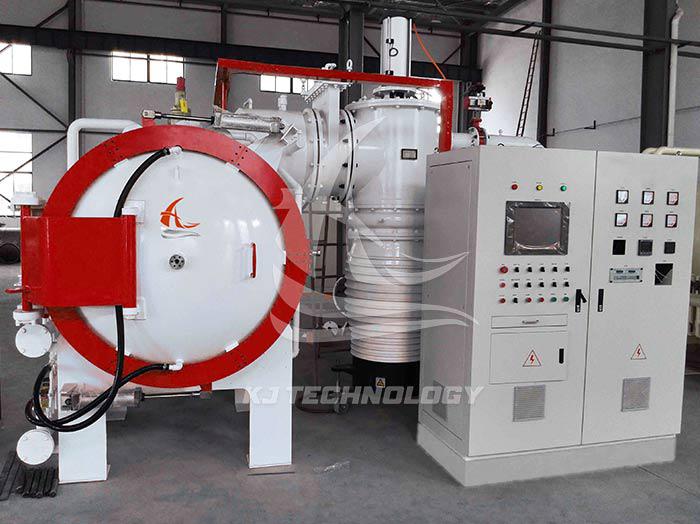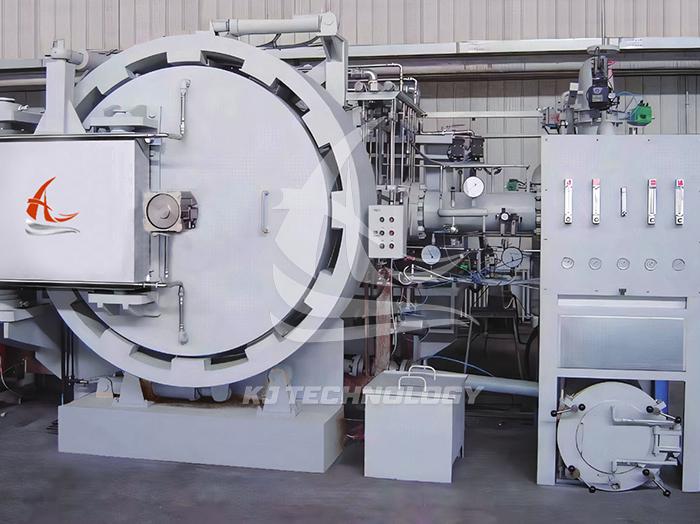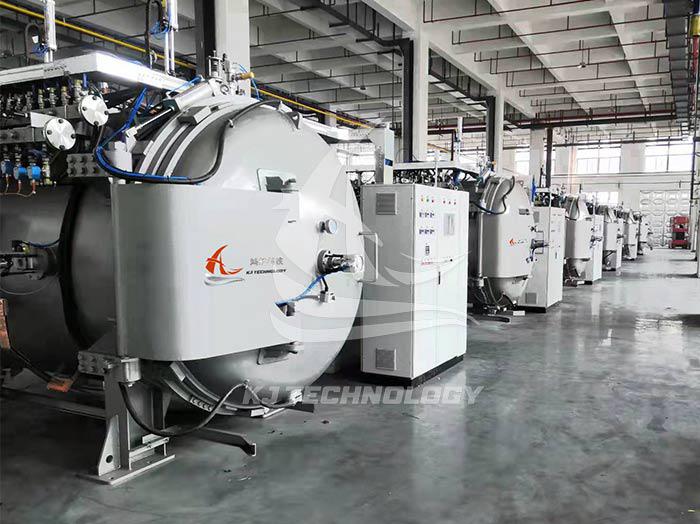Working principle of diffusion welding vacuum furnace
 08-18-2025 Author: KJ technology
08-18-2025 Author: KJ technology
The diffusion welding vacuum furnace uses a vacuum environment, high-temperature heating, and pressure control to promote the diffusion of atoms at the material contact surface to form metallurgical bonds, achieving high-strength solid-state connections. Its working principle can be subdivided into the following steps:
1. Core principle: Solid state diffusion combined with metallurgy
The diffusion welding vacuum furnace utilizes the diffusion behavior of materials in high temperature and high pressure environments to allow atoms on the surface of the workpiece to penetrate each other, forming a metallurgical bond that is consistent with the properties of the base material. Its essence is solid-state atomic diffusion, rather than liquid fusion in welding, which can avoid welding defects (such as pores and cracks), especially suitable for connecting difficult to weld materials such as dissimilar materials, heat-resistant alloys, ceramics, etc.
2. Key process flow
Establishment of vacuum environment
By using multi-stage vacuum systems such as mechanical pumps and diffusion pumps, the pressure inside the furnace is reduced to an extremely low level (usually ≤ 1 × 10 ⁻ ² Pa) to eliminate the influence of oxidation reactions on the welding interface. The vacuum environment can prevent the workpiece from oxidizing at high temperatures, while promoting the sublimation and dissociation of oxides, and removing impurities from the contact surface.
High temperature heating and insulation
By using molybdenum strips, graphite resistors, or high-frequency induction heating methods, the workpiece is heated to a temperature above the recrystallization temperature of the material (usually 0.5-0.8 times the melting point, such as about 800-1000 ℃ for titanium alloys).
At high temperatures, micro protrusions on the surface of the workpiece undergo plastic deformation, increasing the contact area and significantly improving the atomic diffusion rate. The insulation stage (several minutes to several hours) ensures that the diffusion process is fully completed, forming a uniform metallurgical bonding layer.
pressurization
By applying static pressure (usually 0.5-50MPa) through hydraulic or pneumatic systems, micro plastic deformation is generated on the contact surface of the workpiece, eliminating the original interface voids. The pressure should be adjusted according to the material type, thickness, and joint quality requirements to avoid excessive deformation or stress concentration.
Cooling and post-processing
After welding is completed, the workpiece is slowly cooled in a vacuum or inert atmosphere to reduce the risk of cracking caused by thermal stress. Some processes also maintain the welding temperature after releasing pressure, promote recrystallization process, and further optimize joint performance.
3. Equipment structure composition
The diffusion welding vacuum furnace usually consists of the following systems:
Furnace body: Adopting a double-layer water-cooled structure to ensure controllable outer wall temperature at high temperatures while maintaining vacuum sealing.
Heating system: Molybdenum strip or graphite resistance heating element, combined with infrared thermometer or thermocouple to achieve precise temperature control (error ≤ ± 5 ℃).
Pressure system: hydraulic cylinder or pneumatic device, equipped with pressure sensors and servo control system, to achieve pressure gradient loading and stable maintenance.
Vacuum system: multi-stage pumping devices such as mechanical pumps, diffusion pumps, Roots pumps, etc., combined with vacuum gauges to monitor the air pressure inside the furnace.
Control system: PLC or industrial computer integrated control, programmable temperature, pressure, time and other parameters, and equipped with fault diagnosis and protection functions.
4. Technical advantages and application scenarios
advantage
High joint quality: The metallurgical bonding layer has the same performance as the base material, with no residual cast structure, and the strength can reach over 90% of the base material.
Wide applicability: It can weld dissimilar metals, ceramics, intermetallic compounds, and composite materials, solving material combination problems that are difficult to handle in fusion welding.
Small deformation: Low temperature welding (far below melting point) reduces thermal stress and is suitable for precision part processing.
Pollution free: The vacuum environment avoids oxidation and impurities, and the joint has high purity.
Application scenarios
Aerospace: Repair and manufacturing of high-temperature alloy components such as turbine blades and combustion chambers.
Nuclear industry: heterogeneous material connections for nuclear fuel cladding and reactor structural components.
Power electronics: Vacuum diffusion brazing of ceramic insulators and metal conductors.
Medical devices: precision welding of titanium alloy artificial joints and cobalt chromium alloy implants.








